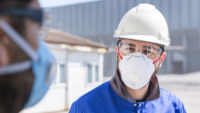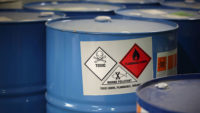2021 Top 10 OSHA Violations: Respiratory Protection, general industry
No. 2 in the Top 10 most frequently penalized OSHA standards for FY 2021

Photo credit: Getty Images
Regulation 29 CFR 1910.134
Key Provisions (relating to COVID-19 protection):
Even when control strategies are in place, PPE, including respirators, will be needed for workers when close contact with someone who is known or suspected of having COVID-19 cannot be avoided. Whenever respirators are required, employers must implement a written, worksite-specific respiratory protection program (RPP), including medical evaluation, fit testing,2 training, and other elements, as specified in OSHA’s Respiratory Protection standard (29 CFR 1910.134). OSHA requirements for other PPE (e.g., eye protection, protective clothing) can be found in OSHA’s General PPE standard (29 CFR 1910.132) and Eye and Face Protection standard (29 CFR 1910.133).
Cloth Face Coverings: These are homemade or commercially available products made of cloth that cover the nose and mouth. Cloth face coverings should NOT be worn instead of an FDA-cleared or authorized surgical mask if protection against exposure to splashes and sprays of infectious material from others is needed. Cloth face coverings do not provide effective respiratory protection for workers when protection against airborne hazards is needed, and do not fall under OSHA’s Respiratory Protection standard.
Face masks: These products look similar to, and are often mistaken for, surgical masks, but do not provide fluid resistance. They do not provide effective respiratory protection for workers when protection against airborne hazards is needed, and do not fall under OSHA’s Respiratory Protection standard. They are not considered PPE for the wearer, but can assist in source control. An example of this type of product would be a KN95 respirator with ear loops instead of head straps and that has not undergone rigorous fit testing to demonstrate a proper fit/effective seal to the wearer’s face.
The key elements of a Respiratory Protection Program that employers must implement when any of their staff are required to wear respirators include the following:
- Assign a suitably trained program administrator to oversee all elements of the RPP. This can be an infection prevention and control practitioner or a nurse administrator. If there are no staff members suitably trained to be the program administrator, consider hiring a local industrial hygiene consulting service to help establish a RPP or contact OSHA’s On-Site Consultation Program.
- Implement and maintain a written RPP that details worksite-specific procedures and elements for required respirator use (e.g., medical evaluation, fit testing, training, maintenance, etc.). Certain program elements may also be required by OSHA for voluntary respirator use in order to prevent potential hazards associated with the use of a respirator.
- Conduct a risk assessment to identify which workers are at risk of exposure to any airborne hazards (e.g., SARS-CoV-2, tuberculosis [TB], Legionella, certain hazardous chemicals).

Looking for a reprint of this article?
From high-res PDFs to custom plaques, order your copy today!







